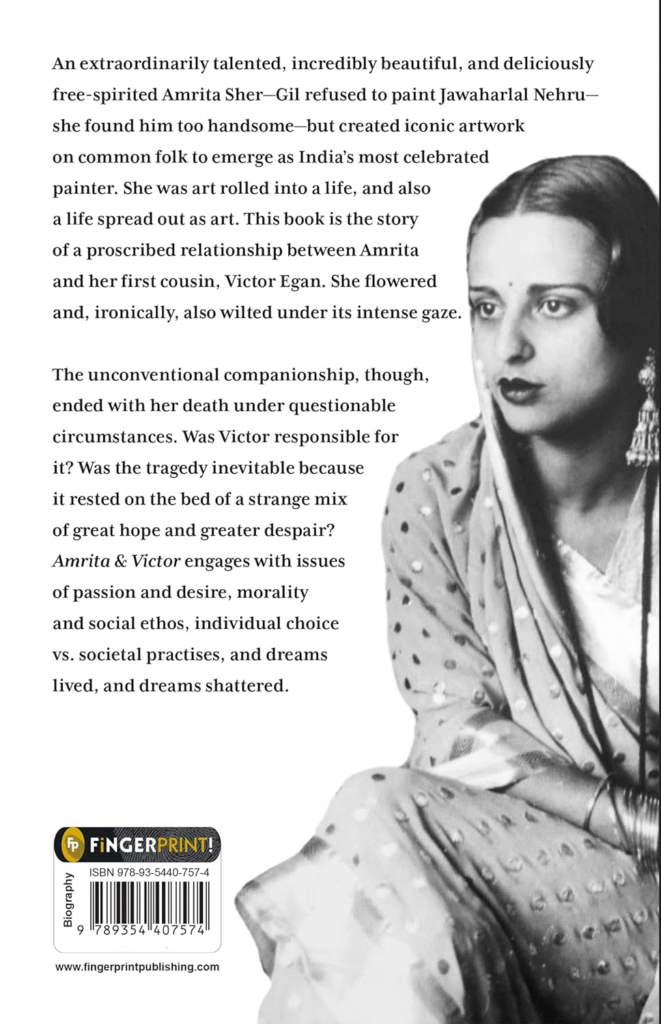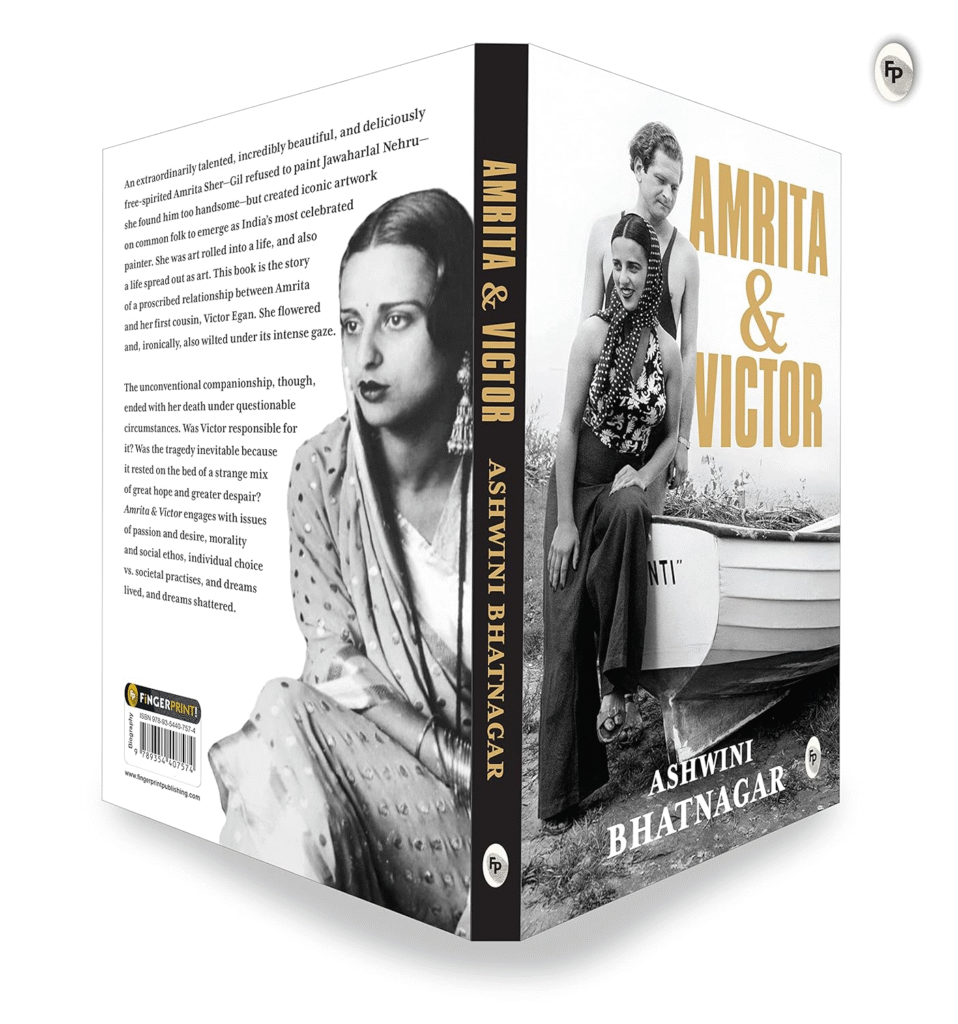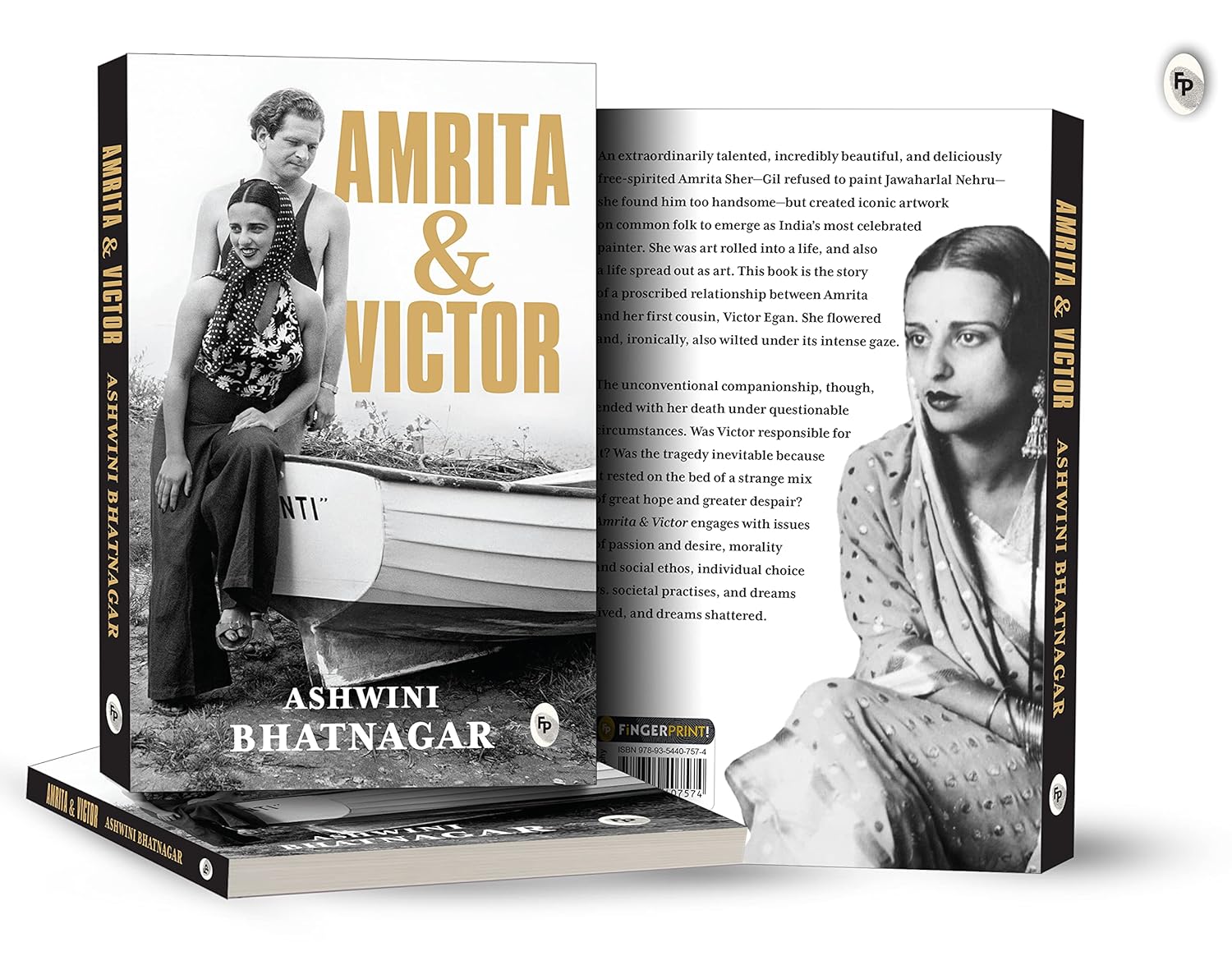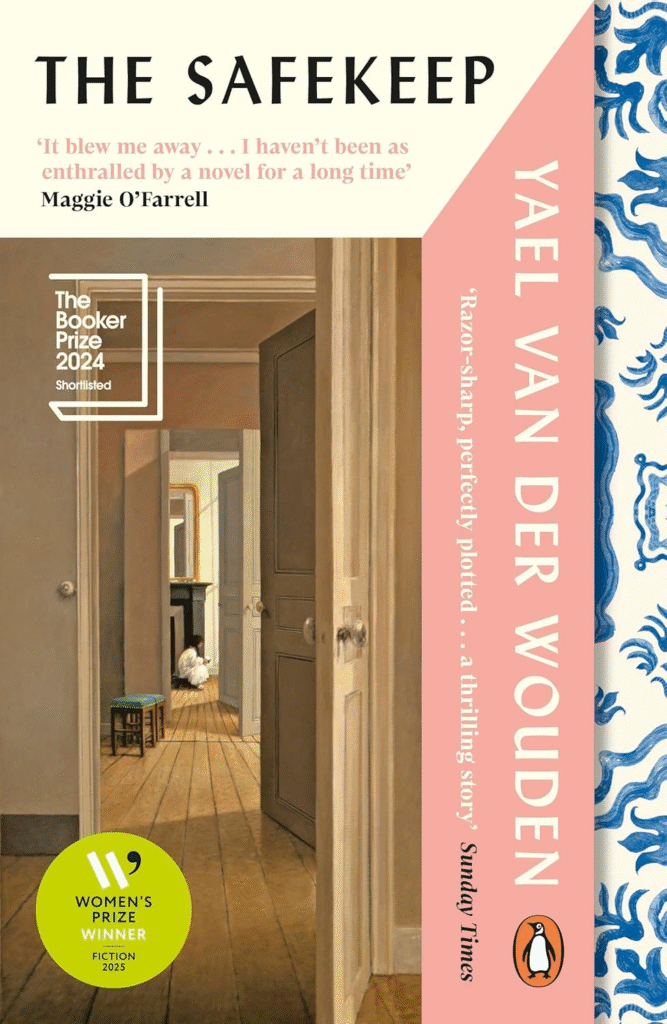Amrita and Victor by Ashwini Bhatnagar, published on 10 April 2023,is a compelling biography that explores the passionate and unconventional love story of Amrita Sher-Gil and Victor Egan. Amrita and Victor by Ashwini Bhatnagar is not just a biography instead it is an intimate, emotionally layered portrait of one of India’s most iconic artists, Amrita Sher-Gil, and her complex, unconventional relationship with her cousin and eventual husband, Victor Egan. Set against the vibrant cultural scenes of pre-Independence India and Europe, this richly detailed Amrita Sher-Gil biography peels back the layers of passion, rebellion, and vulnerability that shaped both her personal life and her artistic journey. The author’s storytelling goes beyond timelines and achievements, bringing to life a deeply personal love story that defied societal expectations.

In Amrita and Victor, Bhatnagar draws from private letters, memoirs, and family anecdotes to explore the raw emotional connection between Amrita and Victor, a relationship marked by its fierce devotion and inner conflict. Through this compelling narrative, the Amrita and Victor book highlights how Amrita’s bold independence as an artist existed alongside her intense need for emotional security. Her deep longing for freedom, yet her desire for companionship, especially with Victor, forms the emotional core of this story. The book doesn’t just chronicle of her art and it also captures the emotional storm that gave it life, making it a standout work in the genre of modern Indian art biography.
What makes Amrita and Victor truly unique is how Ashwini Bhatnagar refuses to reduce Amrita to a one-dimensional figure and a mere rebel or a tragic genius. Instead, he brings out her inner conflicts and emotional evolution, especially in the context of her eventual marriage to Victor Egan. In his interview, Bhatnagar explains that his aim was to “humanize Amrita,” to bring forth not only her sensuality and boldness but also her inner turmoil and search for emotional fulfilment. The book offers a sensitive, multi-dimensional portrayal of Amrita, capturing her humor, contradictions, and courage. It provides valuable insight into the Amrita Sher-Gil Victor Egan love story, without romanticizing or simplifying it.
Throughout Amrita and Victor, readers witness how Amrita’s relationship influenced her decisions not just in love, but in art and identity. The book reminds us that behind every bold stroke on her canvas was a woman both empowered and haunted by her emotional world. From her struggles with parental expectations to her letters filled with longing and clarity, every part of her life is laid bare in this deeply human account. As Ashwini Bhatnagar’s latest book, this story redefines what a biography can be that can be transform into a powerful narrative of love, identity, and the emotional cost of genius. For anyone curious about Victor Egan and Amrita Sher-Gil, or those drawn to stories of powerful women in art, this book is a must-read.
Read Also: Balidan by Swapnil Pandey | Para SF Hero Stories
Book Availability, Formats, and Pricing
Amrita and Victor by Ashwini Bhatnagar was published on 10 April 2023 by Fingerprint! Publishing. Written in English, the book has 216 pages in its paperback format. It is available in two editions, Kindle for ₹180 and paperback for ₹189. Readers can easily buy this book online through platforms like Amazon India, Goodreads and Flipkart, or find it in leading bookstores across the country.
About the Author of Amrita and Victor: Ashwini Bhatnagar
Ashwini Bhatnagar is a well-known Indian author and senior journalist with more than 30 years of experience in print, television, and documentary writing. He has worked with major newspapers like The Times of India, The Tribune, The Pioneer, and Sunday Mail, where he covered a wide range of topics related to society, politics, and culture.
He has written over sixteen books, including The Lotus Years, a biography of Rajiv Gandhi that was shortlisted for TataLit Live’s Best Non-Fiction Book of the Year in 2020, and Starring Mahjabeen as Meena Kumari, a biography of the legendary Bollywood actress. His books often attract interest for screen adaptations, showing how engaging and cinematic his storytelling is.

Ashwini Bhatnagar is also a documentary filmmaker. One of his important projects is Diary of a Kashmiri Pandit, presented by Deepti Naval, which tells the painful story of the migration of Kashmiri Pandits.
His book Amrita and Victor brings to light the real and emotional story of artist Amrita Sher-Gil and her partner Victor Egan. Ashwini Bhatnagar has clearly stated that everything in the book is based on facts, and nothing has been made up. His writing reflects honesty, deep research, and a genuine effort to understand the emotional side of his subjects.
Read Also: Major Shaitan Singh Book Review by Jai Samota
Thematic Analysis of Amrita and Victor
- The Power of Private Letters as Emotional Archives: One of the most moving elements in Amrita and Victor is the inclusion of Amrita Sher-Gil’s personal letters. These are not just historical records instead they are emotional documents that show how deeply she felt, loved, feared, and doubted. The letters become the emotional core of the narrative, allowing readers to witness her vulnerability in real time. In a world where Amrita Sher-Gil is often seen as bold and untouchable, these letters ground her as achingly human. This approach distinguishes Amrita and Victor book from other traditional artist biographies by giving voice to private emotions.
- Love as Resistance in Colonial India: The book does not just talk about romance and it shows how Amrita Sher-Gil’s love for Victor Egan was itself a rebellious act. Inter-religious, inter-cultural, and defiant of societal norms, their relationship stood in stark contrast to the conservative moral codes of pre-Independence India. Their eventual marriage was not simply a personal decision but a form of resistance against colonial structures, family expectations, and societal control. This book shows their story in a larger historical context, connecting their love with broader conversations on freedom, identity, and self-determination.
- The Emotional Cost of Being a Woman Genius: In Amrita and Victor, Ashwini Bhatnagar touches upon the loneliness and emotional fragmentation that often accompanied Amrita’s genius. The book quietly explores a powerful truth: that being a revolutionary woman artist came with a heavy emotional toll. Her quest for emotional security especially in Victor did not always align with her independent image. This duality makes her story relatable and tragic. Unlike other Amrita Sher-Gil biographies, this book emphasizes the psychological cost of being a woman ahead of her time.
- Victor Egan: The Silent Pillar of Support: Most books about Amrita Sher-Gil focus solely on her, but Amrita and Victor gives due space to Victor Egan’s role and not just as a romantic partner, but as a stabilizing presence in her chaotic emotional world. He was more than a lover; he was someone who understood her contradictions, accepted her complexities, and remained emotionally available despite repeated rejection. The book is not just about Amrita’s journey, it is about male emotional labor, something rarely addressed in modern Indian art biographies. Victor’s patience and compassion add a fresh dimension to the love story.
- The Conflict Between Public Persona and Private Self: Amrita Sher-Gil’s public image as a bold, progressive icon often hides the emotional fragility and personal struggles she faced behind closed doors. In Amrita and Victor, we see a woman who appeared fearless in public yet often sought reassurance and emotional grounding in her private life. This theme highlights how the public figure of Amrita Sher-Gil was not always in sync with the woman she was in her personal letters to Victor. The book carefully unpacks this tension, showing how performance and perception shaped her identity.
- Marriage Without Conformity: The marriage between Amrita and Victor was not a traditional union because it was a relationship based on emotional need, mutual understanding, and personal freedom. Even within marriage, they maintained an unusual level of independence, challenging the expectations of a man-woman relationship in colonial society. This book explores the radical idea of a non-conformist marriage, where both partners loved differently but sincerely. In today’s context, Amrita and Victor opens up conversations around alternative relationships and love outside predefined gender roles.
- Art as a Reflection of Emotional Turmoil: Though the book Amrita and Victor does not dwell extensively on her body of work, it draws important links between Amrita’s emotional state and the tone of her paintings. Bhatnagar subtly suggests that her canvases often filled with solitude, bold colour, and intense expression and mirror her inner world. Her work was shaped not just by politics or technique, but by her evolving emotions, especially those around Victor. This connects Amrita Sher-Gil’s art directly with her psychological life, showing how her love story informed her creative evolution.
- Family Tensions and Emotional Isolation: Another undercurrent in Amrita and Victor book is the emotional distance Amrita felt from her family. Her choices of romantic, personal, and artistic need often alienated her from both Indian and European relatives. Victor became her emotional refuge in this isolation. The theme of family rejection is key to understanding why Amrita’s bond with Victor was so intense because it was not just love, it was survival. Her inner circle was limited, and this added layers of dependency and volatility to their relationship.
- The Colonial Backdrop: Cross-Cultural Tensions: Set during a time when India was still under British rule, Amrita and Victor unfolds across geographies and ideologies across Hungary, France, India. The book reflects the cross-cultural confusion that Amrita often felt, especially as a woman with a mixed heritage trying to belong to both Indian and European societies. Her relationship with Victor existed in this in-between space. This theme reveals how colonialism did not just affect politics but it shaped identities, relationships, and even art. It makes the Amrita Sher-Gil Victor Egan love story a story of cultural displacement too.
- Emotional Honesty as a Literary Style: Ashwini Bhatnagar’s narrative style is one of the most powerful elements of the book. He does not exaggerate or dramatize Amrita’s story. Instead, he relies on emotional honesty, restraint, and clarity to build a connection with readers. This theme explores how the author’s own voice helps elevate Amrita and Victor from mere biography to a deeply felt experience. His decision to focus on emotional truths over artistic legacy gives the book a rawness that is rare in modern Indian biographies.
- India Belongs Only to Me: One of the most powerful moments in the Amrita and Victor book is Amrita Sher-Gil’s unapologetic claim: “Europe belongs to Picasso, Matisse, Braque and many others. India belongs only to me.” This bold statement captured her artistic vision and a refusal to follow in the footsteps of Western painters and a deep-rooted desire to represent India through her own lens. Unlike many contemporaries who tried to imitate European styles, Amrita created a unique visual language that merged European technique with Indian subjects especially rural women, peasants, and daily life. This theme in the Amrita Sher-Gil biography highlights her journey to becoming one of the earliest and most authentic voices in modern Indian art. She chose India not because they were fashionable, but because they were personal. Her canvases were filled with the melancholy and grace of ordinary Indian lives. By centring her work in India’s realities and rejecting superficial exoticism, Amrita established herself as a pioneer whose influence endures in every serious discussion on Indian art today.
- Defiant in Love and Loyalty: Amrita and Victor is not just about art and it’s about a woman who lived, loved, and resisted on her own terms. One of the most revealing aspects of this Amrita Sher-Gil biography is her decision to say no to painting Jawaharlal Nehru, despite his personal admiration for her. This was not mere artistic choice but it was a firm statement of independence. Amrita did not want to be part of political propaganda or elitist flattery. Her art belonged to no one not even the state. The book also gives rare insight into her many romantic relationships before marrying Victor Egan. These experiences were not kept secret or painted with guilt; they were part of her journey toward self-knowledge. Her openness in love was as radical as her painting brush. She lived her emotional life without shame, far ahead of her time. Amrita’s close friendship with Sarojini Naidu, one of India’s leading political and literary voices, added yet another layer to her already complex identity. Though she moved in political and intellectual circles, Amrita remained unaligned and fiercely personal.
Amrita Sher-Gil passed away suddenly in 1941 at the age of 28, while she was pregnant. Her husband, Victor Egan, was by her side during her final days and had even arranged for an emergency surgery as he was doctor, but she died before it could take place. Her untimely death shocked those close to her and cut short a life filled with artistic passion and emotional depth. Despite her early passing, Amrita’s fearless spirit and unique artistic voice continue to inspire, and Victor remained deeply impacted by the loss of the woman he loved.
Read Also: In Her Defence Book Review | Gender Equality
Why This Book Deserves Your Attention
If you are looking for a deeply emotional and real story, Amrita and Victor is the book you need. It goes beyond the usual Amrita Sher-Gil biography and offers a fresh, intimate view of one of India’s most iconic artists. What sets this book apart is how Ashwini Bhatnagar presents Amrita’s world into raw, fearless, and liberating. The author does not judge her choices; instead, he lets her speak through powerful dialogues and honest portrayals, making this a must-read for those interested in Indian women artists who shaped modern Indian thought.

This book is not just a retelling of facts but it is a lyrical journey through art and love, told in a way that moves swiftly and clearly. The Amrita and Victor book captures the emotional tensions of Amrita’s relationship with Victor Egan, giving insight into how their bond shaped her identity and artistic expression. The prose is fluid, yet strong. It is rare to find a male writer who brings such depth and tenderness to a female character’s emotions. That sensitivity makes this book a unique gem in the genre of artist love stories.
One of the most compelling reasons to pick up Amrita and Victor is how it beautifully blends history with personal drama. You do not just read about Amrita Sher-Gil’s life, you feel her internal struggles, her rebellion against societal norms, and her bold defiance in love. Her refusal to paint Nehru, despite being offered the opportunity, speaks volumes about her independence. If you love books with real-life love stories filled with courage and complexity, this book will stay with you long after you have turned the last page.
Another reason to read this is the sheer brilliance of its literary style. The author’s writing flows easily and is filled with expressive moments that keep you hooked. From Paris to India, the book travels with Amrita capturing not just her geographical journey, but her evolution as a modern Indian artist. Her struggles, her growth, her defiance, all come alive in Ashwini Bhatnagar’s hands. And that makes this not just a biography, but a soulful experience.

In a world filled with half-baked love stories and one-dimensional portrayals, Amrita and Victor gives you a balanced, research-backed, emotionally rich story. It is a beautiful intersection of art, identity, and relationships. Whether you are an art lover, a reader of feminist voices, or simply someone who enjoys a gripping biography, this book will resonate with you. And that is what makes it a must-read in the growing world of Indian biography books.
Final Thought
Amrita and Victor by Ashwini Bhatnagar is more than just a biography instead it is a powerful story of love, art, and rebellion. Through well-researched details and emotional storytelling, the book brings to life the deep connection between Amrita Sher-Gil and Victor Egan. It shows how love influenced Amrita’s personal choices and her identity as a modern Indian artist.
If you enjoy reading about real people, untold love stories, and the struggles of strong women, this book is a must-read. With its easy language, fast pace, and touching moments, Amrita and Victor leaves a lasting impression and deserves a place on every reader’s shelf. It is a shining example of how biography books about Indian artists can be both emotional and inspiring.
Read Also: A Billion Butterflies by Jagadish Shukla




